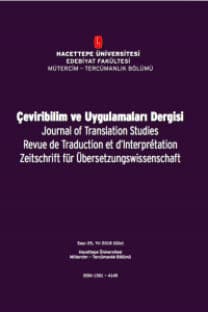Yazılı Metinden Sözlü Çeviride ‘Garden-Path’ Tümcelerin İşlemlenmesi: Deneysel bir Çalışma
‘Garden-path’ kavramı, tümce işlemleme sırasında öbek yapılarının söz diziminden kaynaklı kısa süreli anlam belisizliğini ifade etmektedir (Fromkin, Rodman & Hymas, 2011, s. 385). Bu çalışma, yazılı metinden sözlü çeviri eğitimi almış çevirmenlerin, ‘garden-path’ etkisini, bu konuda eğitim almamış çevirmenlere göre, daha kolay çözümleyip çözümleyemediklerini ortaya koymayı amaçlamaktadır. Yazılı metinden sözlü çeviri sırasında çevirmenin bu tümcelerin içerdiği anlamı kavrayabilmesi için sözdizimsel öğeleri doğru bir şekilde ayrıştırması ve tümcen-in anlamını erek dilin sözdizimine uygun olarak yeniden düzenlemesi gerekmektedir. Çevirmen-lerin yazılı metinden sözlü çeviride garden-path tümcelerini çözümlemedeki performansını test etmek üzere bir deney tasarlanmıştır. Deney ve kontrol gruplarındaki katılımcılara yazılı metin-den sözlü çeviri yapmak üzere farklı bağlamlarda beş ‘garden-path’ tümcesi verilmiş ve kendilerinden çeviri sırasında seslerini kaydetmeleri istenmiştir. Çalışmanın sonuçları yazılı metinden sözlü çeviri alanında eğitim almış çevirmenlerin tümceleri daha çok bir bütün olarak ele aldığını ve ilgili çeviri türüne özgü beceri ve tekniklerden faydalanarak tümcelerin içerdiği mesaja odaklandıklarını göstermiştir. Bu bağlamda, belli becerileri edinmiş çevirmenler, ‘gar-den-path’ etkisi içeren karmaşık tümcelerin sözdizimlerini ayrıştırmada sıradan okuyuculardan daha başarılıdır.
Processing Garden-Path Sentences in Sight Translation: An Experimental Study
Garden-path refers to a type of temporary syntactic ambiguity in which the phrase structure rules allow two possible attachments of a constituent (Fromkin, Rodman & Hymas, 2011, p. 385). This study aims to investigate whether sight translators who are trained on this type of translation perform better in overcoming garden-path effect than other translators who are not trained on sight translation. During the translation process of such sentences, the sight transla-tor is expected to parse the syntactic order of the source text correctly to grasp the meaning, and reformulate the message in the target language applying the necessary transpositions in the word order. An experiment was designed to test the performance differences in sight trans-lation of garden-path sentences. Experimental and control groups were given five garden-path sentences within various contexts and were asked to record their voices. The results showed that trained sight translators tend to receive garden-path sentences as a whole and concentrate on the message of the sentence, making use of certain skills and techniques in reading. In this sense, trained sight translators are more successful in parsing complex sentences with garden-path effect than ordinary readers.
___
- Agrifoglio, M. (2004). Sight translation and interpreting: A comparative analysis of constraints and failures. Interpreting, 6(1), 43-67.
- Baddeley, A. D., & Hitch, G. (1974). Working memory. In G. H. Bower (Ed.). The psychology of learning and motivation (Vol. 8) (pp. 47–89). Academic Press.
- Baddeley, A. (1986). Working memory. Oxford University Press.
- Carroll, D. W. (2008). Psychology of Language. Brooks/Cole Publishing Company.
- Ersözlü, E. (2005). Training of interpreters: Some suggestions on sight translation. Translation Journal, 9(4). https://www.translationjournal.net/journal/34sighttrans.htm
- Fromkin, V., Rodman, R. & Hyams, N. (2011). An Introduction to Language. Wardsworth.
- Harley, T. (2005). Psychology of Language: From Data to Theory. Psychology Press Ltd. and Tay-lor and Francis Inc.
- Krapivkina, O. A. (2018). Sight translation and its status in training of interpreters and transla-tors. Indonesian Journal of Applied Linguistics, 7 (3), 695-704.
- Lambert, S. (2004). Shared Attention during Sight Translation, Sight Interpretation and Simulta-neous Interpretation. Meta, 49 (2), 294–306. https://doi.org/10.7202/009352ar
- Mikkelson, H. (1995). Introduction to Sight Translation Chapter from the Interpreter’s Edge. Retrieved November 30, 2020 from https://acebo.myshopify.com/pages/introduction-to-the-sight-translation-chapter-from-the-interpreters-edge-generic-edition
- Neveu, A. (2018). Context Effects in Reading for Translation: Early Target Language Activa-tion. (Electronic Thesis or Dissertation). Retrieved from https://etd.ohiolink.edu/
- Pickering, M. J. & van Gompel, R. P. G. (2006). Syntactic Parsing. In Traxler M. J. & Gerns-bacher M. A. (Eds.) Handbook of Psycholinguistics. Elsevier.
- Pratt, S. (1991). French L'importance de la traduction à vue pour l'enseignement de l'interpréta-tion. Proceedings of the XIIth World Congress of Fit in Belgrade (pp. 596-605). Prevodi-lac.
- Pöchhacker, F. (2004) Introducing Interpreting Studies. Routledge Taylor and Francis Group.
- Shreve, G. M., Lacruz, I. & Angelone, E. (2010). Cognitive effort, syntactic disruption and visual interference in a sight translation task. In Gregory M. Shreve & Erik Angelone (Eds.), Translation and Cognition (pp. 63-84). John Benjamins.
- Viezzi, M. (1990). Sight translation, simultaneous interpretation and information retention. In L. Gran & C. Taylor (Eds.) Aspects of Applied and Experimental Research on Conference Inter-pretation (pp. 54–61). Campanotto.
- Yayın Aralığı: Yılda 2 Sayı
- Başlangıç: 1991
- Yayıncı: Hacettepe Üniversitesi
Sayıdaki Diğer Makaleler
Özolguların Türkçeden Rusçaya Çevirisi Sorunu
Linda MIĞDIS ŞEKER, Emine DEMİREL
Hasan Erkek’in Eşik Adlı Oyunundaki Deyim ve Eğretilemelerin Çevirisi: Zorluklar ve Çözüm Önerileri
Türkiye’deki Mütercim ve Tercümanların Mesleki Statüleri: Öğrenci ve Çevirmenlerin Algıları
Duygu İŞPINAR AKÇAYOĞLU, Ömer ÖZER
Covid-19 Pandemi Sürecinde 14 Kuralın Türk İşaret Dili Çevirileri Üzerine Bir İnceleme
Metinsiz Geri Çevirilerin Yan Metin Çevirisinde Çeviri Kararları ve Yöntemleri
Aslı Özlem TARAKCIOĞLU, Müge KALIPCI
Yazılı Metinden Sözlü Çeviride ‘Garden-Path’ Tümcelerin İşlemlenmesi: Deneysel bir Çalışma
